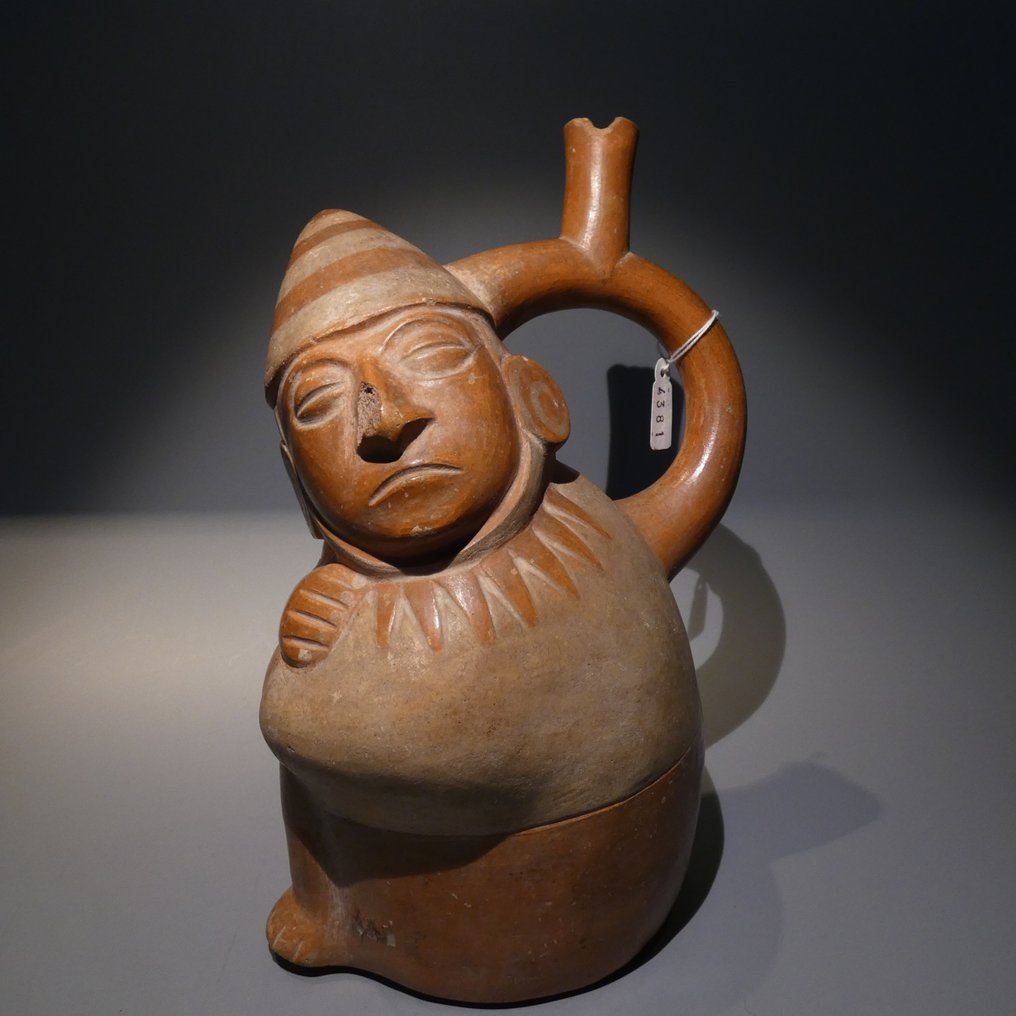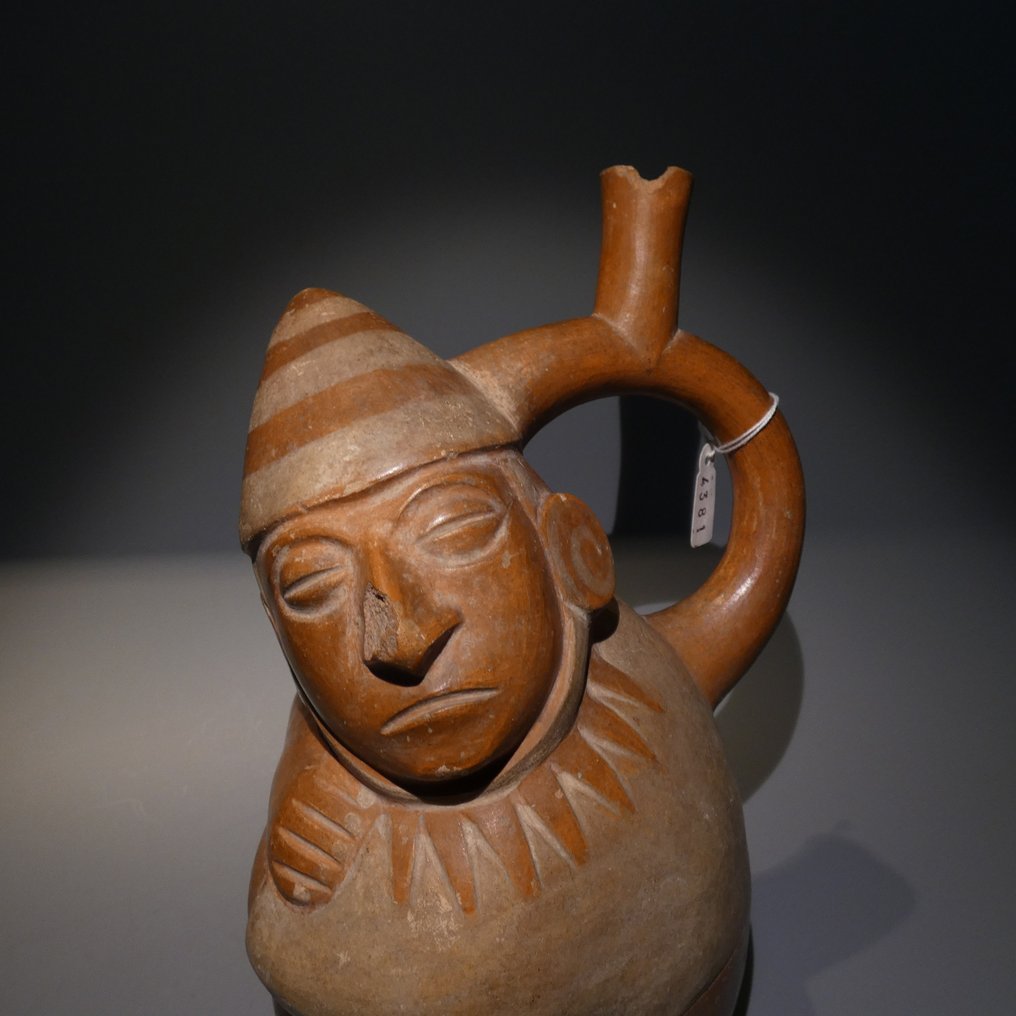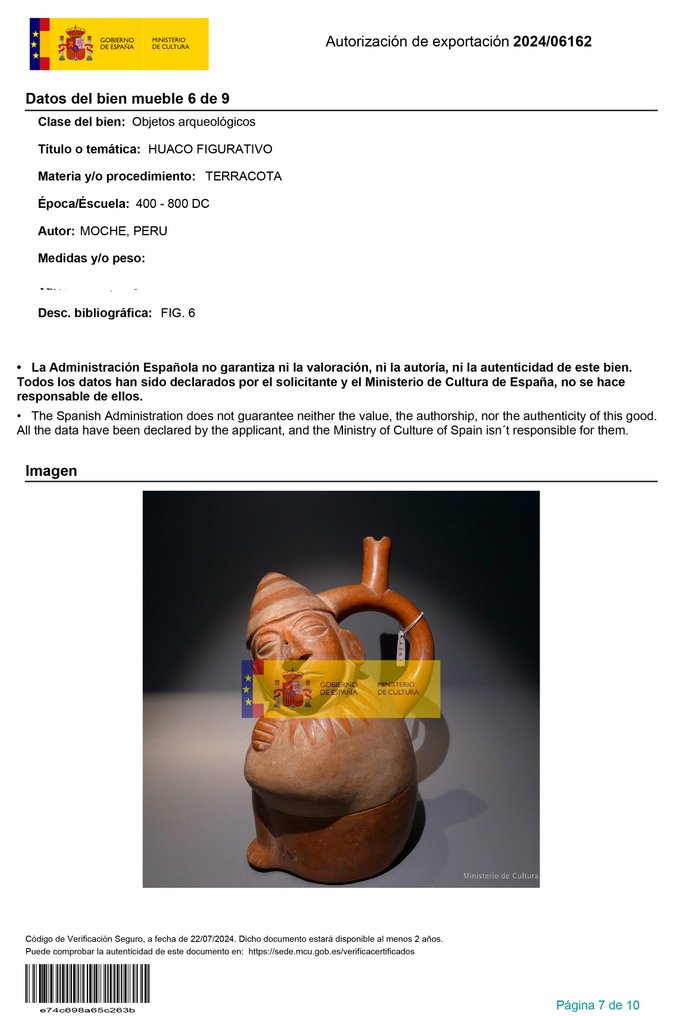Perfect and quick delivery. Happy new year
Voir la traductionMoche, Pérou, Terre cuite Belle statue de chef Huaco. 23 cm de hauteur. 400 - 800 après J.-C. Licence d'exportation espagnole
Nº 92788833



Fine Stirrup jar Huaco figure of a chief
Moche, Peru, 400 - 800 AD.
Terracotta and pigments
23 cm height
Provenance:
- Private collection, J. R. (1928 - 2013) Barcelona, formed since 1950 until 2000. Thence by descendent. Old label of the collection number 4381.
DOCUMENTS:
- Spanish Export License.
Condition: Good condition, see photos.
The Moche culture inhabited the coast of present-day northern Peru, concentrating in the valleys of Lambayeque, Chicama, Moche and Virú. This desert region is crossed by several rivers that flow down into the Pacific Ocean, where marine resources are plentiful.
The Moche produced fine ceramic, textile and precious metal pieces. Their characteristic style can be seen in a wide range of goods such as fire-engraved gourds, wall murals, featherwork art, body painting and tattoos. Their ceramic decoration displays a level of skill that has rarely been surpassed, and included such techniques as incision, bas-relief with stamps, and painting on smooth surfaces. Many were made in state-run workshops that mass-produced pieces from molds. Their ceramics came in a variety of forms and decorative styles and displayed myths and ritual motifs as well. Notable among these earthenware forms were the so-called “portrait bottles”, bottles molded with the face of a well-known Moche figure. These highly detailed facial portraits reflect the Moche’s own use of face paint and/or tattoos, as well as elaborate headdresses. This portrait-making expertise can also be observed in everyday scenes and erotic representations, as well as in figures of individuals that were hunch backed, blind, or suffered from other disorders. They were skillful metalworkers, using gold, copper and silver to make ear ornaments, nose rings, bracelets, necklace beads, tweezers and a variety of tools. Especially notable is the tumi or ceremonial knife that was usually only carried by Moche officials.
Moche ceramics provide detailed representations of the culture’s supernatural world, including deities, myths, sacred animals and ceremonial practices. Their deities take the form of foxes, owls, hummingbirds, falcons and felines. These figures were servants of greater gods that had human form and sported elaborate outfits and ferocious faces with crossed fangs.
Tombs of important Moche individuals were rectangular and made of adobe, with niches for offerings. Some bodies were laid on cane mats, while others were left in caves inside cane coffins. People of the elite class were buried with metal masks and a rich array of grave goods, servants and animals accompanying them. The famous “Lord of Sipán” is the most notable example of this kind of burial.
Notes:
- The piece includes authenticity certificate.
- The piece includes Spanish Export License (Passport for European Union). NOT TAXES.
- According to Spanish legislation, items sent outside the European Union are subject to export taxes and will be added to the invoice, at the buyer's expense. These export fees are fixed on the final auction price and the tax rate is not applied directly on the total value of the item to be exported, but rather the different percentages by sections are applied to it:
- Up to 6,000 euros: 5%.
- From 6,001 to 60,000 euros: 10%.
This export permit application process can take between 1-2 months maximum.
- The seller guarantees that he acquired this piece according to all national and international laws related to the ownership of cultural property. Provenance statement seen by Catawiki.
À propos du vendeur
Fine Stirrup jar Huaco figure of a chief
Moche, Peru, 400 - 800 AD.
Terracotta and pigments
23 cm height
Provenance:
- Private collection, J. R. (1928 - 2013) Barcelona, formed since 1950 until 2000. Thence by descendent. Old label of the collection number 4381.
DOCUMENTS:
- Spanish Export License.
Condition: Good condition, see photos.
The Moche culture inhabited the coast of present-day northern Peru, concentrating in the valleys of Lambayeque, Chicama, Moche and Virú. This desert region is crossed by several rivers that flow down into the Pacific Ocean, where marine resources are plentiful.
The Moche produced fine ceramic, textile and precious metal pieces. Their characteristic style can be seen in a wide range of goods such as fire-engraved gourds, wall murals, featherwork art, body painting and tattoos. Their ceramic decoration displays a level of skill that has rarely been surpassed, and included such techniques as incision, bas-relief with stamps, and painting on smooth surfaces. Many were made in state-run workshops that mass-produced pieces from molds. Their ceramics came in a variety of forms and decorative styles and displayed myths and ritual motifs as well. Notable among these earthenware forms were the so-called “portrait bottles”, bottles molded with the face of a well-known Moche figure. These highly detailed facial portraits reflect the Moche’s own use of face paint and/or tattoos, as well as elaborate headdresses. This portrait-making expertise can also be observed in everyday scenes and erotic representations, as well as in figures of individuals that were hunch backed, blind, or suffered from other disorders. They were skillful metalworkers, using gold, copper and silver to make ear ornaments, nose rings, bracelets, necklace beads, tweezers and a variety of tools. Especially notable is the tumi or ceremonial knife that was usually only carried by Moche officials.
Moche ceramics provide detailed representations of the culture’s supernatural world, including deities, myths, sacred animals and ceremonial practices. Their deities take the form of foxes, owls, hummingbirds, falcons and felines. These figures were servants of greater gods that had human form and sported elaborate outfits and ferocious faces with crossed fangs.
Tombs of important Moche individuals were rectangular and made of adobe, with niches for offerings. Some bodies were laid on cane mats, while others were left in caves inside cane coffins. People of the elite class were buried with metal masks and a rich array of grave goods, servants and animals accompanying them. The famous “Lord of Sipán” is the most notable example of this kind of burial.
Notes:
- The piece includes authenticity certificate.
- The piece includes Spanish Export License (Passport for European Union). NOT TAXES.
- According to Spanish legislation, items sent outside the European Union are subject to export taxes and will be added to the invoice, at the buyer's expense. These export fees are fixed on the final auction price and the tax rate is not applied directly on the total value of the item to be exported, but rather the different percentages by sections are applied to it:
- Up to 6,000 euros: 5%.
- From 6,001 to 60,000 euros: 10%.
This export permit application process can take between 1-2 months maximum.
- The seller guarantees that he acquired this piece according to all national and international laws related to the ownership of cultural property. Provenance statement seen by Catawiki.
À propos du vendeur
- 100
- 2
- 1
Amazing within 3 days it arrives.
Voir la traductionAll went fine. Fast and secured shipping.
Voir la traductionUna preciosa terracota. Como siempre el vendedor profesional y de confianza.
Voir la traductionParfait ! Merci beaucoup pour le socle, il est très apprécié ;-)
Voir la traductionMooi beeldje, zorgvuldig ingepakt onbeschadigd ontvangen. ik ben er erg blij mee. Veel dank. Met vriendelijke groet Jurriaan Vleghert
Voir la traductionperfetto
Voir la traductionVendeur à recommander, rapide et efficace
Voir la traductionSchönes Rollsiegel
Voir la traductionGood job!
Voir la traductionComo esperaba.
Voir la traductionTodo perfecto gracias
Voir la traductionAlles bestens
Voir la traductionAlles bestens
Voir la traductionDer Uschepti wurde sehr schnell verschickt und war sehr sehr gut verpackt. Danke für das wunderschöne Stück.
Voir la traductiontutto perfetto, eccellente!
Voir la traductionNice item, good and fast shipping
Voir la traductionPersona seria e corretta che fa fronte alle consegne in brevissimo tempo. Oggetto conforme alle foto pubblicate.
Voir la traductionArrived well packed and in good condition! Gracias!
Voir la traductiontutto ok
Voir la traductionA beautiful piece. Very happy. Thank you very much.
Voir la traductiontodo perfecto
Voir la traductionOggetto come da foto arrivato in tempi brevissimi e protetto per la spedizione con le dovute cautele.Serietà del venditore. G.
Voir la traductionCe vendeur est parfait, livraison rapide, les objets sont bien emballés et le transporteur DHL super. L'objet est arrivé en parfait état et la découverte est magnifique et pleine d'émotions. Merci Vi
Voir la traductionMagnifique de travailler avec vous, livraison très rapide, emballage parfait livreur géniaux. L'objet est merveilleux et très émouvant en parfait état. Merci Viviane
Voir la traduction- 100
- 2
- 1
Perfect and quick delivery. Happy new year
Voir la traductionMentions légales
Le vendeur garantit que l'objet a été obtenu légalement et est en mesure de le prouver. Le vendeur a été informé par Catawiki qu'il devait fournir les documents requis par les dispositions législatives et réglementaires de son pays de résidence. Le vendeur garantit qu’il est autorisé à vendre/exporter cet objet. Le vendeur fournira à l'acheteur toutes les informations connues sur la provenance de l'objet. Le vendeur veillera à ce que tous les permis nécessaires soient (déjà) obtenus. Le vendeur informera immédiatement l'acheteur en cas de retard dans l'obtention de ces permis.
Le vendeur garantit que l'objet a été obtenu légalement et est en mesure de le prouver. Le vendeur a été informé par Catawiki qu'il devait fournir les documents requis par les dispositions législatives et réglementaires de son pays de résidence. Le vendeur garantit qu’il est autorisé à vendre/exporter cet objet. Le vendeur fournira à l'acheteur toutes les informations connues sur la provenance de l'objet. Le vendeur veillera à ce que tous les permis nécessaires soient (déjà) obtenus. Le vendeur informera immédiatement l'acheteur en cas de retard dans l'obtention de ces permis.